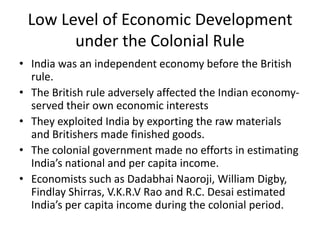
Economic Development under the Colonial rule.pptx
- 1. Low Level of Economic Development under the Colonial Rule • India was an independent economy before the British rule. • The British rule adversely affected the Indian economy- served their own economic interests • They exploited India by exporting the raw materials and Britishers made finished goods. • The colonial government made no efforts in estimating India’s national and per capita income. • Economists such as Dadabhai Naoroji, William Digby, Findlay Shirras, V.K.R.V Rao and R.C. Desai estimated India’s per capita income during the colonial period.
- 2. Features of Indian Agriculture sector on the Eve of Independence • Low agricultural productivity • High vulnerability • Indebtedness of the tillers of the soil • Prominent consumption of the owners of the soil • Small and fragmented landholdings
- 3. Causes of India’s agriculture Stagnation during the colonial period • Land Revenue System • High dependency on monsoon • Lack of resources • Commercialization of agriculture
- 4. Industrial Sector • Declining of the Handicraft Industries • REASONS: • 1. Biased tariff policy • Unfair competition • Disappearance of princely courts • Western Lifestyle
- 5. Foreign Trade • India had place in the foreign trade activities before the British rule. However, the policies made by the colonial government adversely affected the foreign trade: • Policies made India an importer of final consumer goods from British industries and an exporter of raw materials. • In 1869, the Suez Canal was opened. • The colonial government maintained monopoly over India’s foreign trade for its own economic interests. • This practice resulted in the restriction of more than 50% of India’s foreign trade to British and the rest to other countries.
- 6. Demographic Condition • Higher Birth and death Rate • High infant mortality Rate • Low Life Expectancy Rate • Mass illiteracy • Low standard of Living
- 7. Occupational Structure • Agricultural sector • Prime occupation during the colonial government was farming. • Under farming, approximately 70–75% of the population depended on the agricultural sector for their subsistence. • There existed regional variation in the occupational pattern. • States such as Tamil Nadu, Kerala, Andhra Pradesh, Karnataka, Maharashtra and West Bengal showed a declining trend of dependency on the agricultural sector. • Punjab, Odisha and Rajasthan showed an increase in the share of workforce engaged in agriculture.
- 8. • Manufacturing sector • Approximately 10% of the total population was engaged in the manufacturing sector during the colonial government. • India had a well-developed industrial base before British entry. • However, the colonial government’s unfair policies ruined the industrial sector of India.
- 9. • Service sector • Approximately 15–20% of the total population was engaged in the service sector during the colonial period.
- 10. economic challenges at the time of Independence. • Low level of agricultural productivity: The British government took advantage of India’s agricultural sector for its own profitability. Hence, India’s agricultural sector was badly exploited and experienced stagnancy, a low level of productivity and a lack of investment. Slow progress in the industrial sector: India could not develop its industrial sector under the British rule because they faced tough competition from the British industries and lacked capital, infrastructure and technology. • Poor infrastructure: There were no proper infrastructure facilities to impart technical knowledge to labourers and to develop trading and commerce in the economy. There was also a need to upgrade and expand the railway network. Poverty: The plight of the Indian population at the time of independence was poor as the colonial government used India’s wealth for the development of its home country.
- 11. Positive contributions made by the British in India • Positive contributions made by the British: Introduction of railways: The British introduced the railway system and a huge network of transportation helped in the economic and social growth of India. Development of means of communication: The colonial government introduced the most modern and well-organised system of communication. Introduction of the laws and justice system: The colonial government outlined a system of laws and established courts for justice to maintain law and justice in the country. Political and economic unification of the country: Under the British rule, political and economic unification was first established in India. Commercialisation of agriculture: The colonial government took steps to commercialise agriculture. This changed the attitude of Indian farmers and they started producing agricultural products according to requirements. Introduction to English language: English helped Indians to integrate with other countries. Knowing the language also helped Indian manufacturers to communicate with producers from other countries.